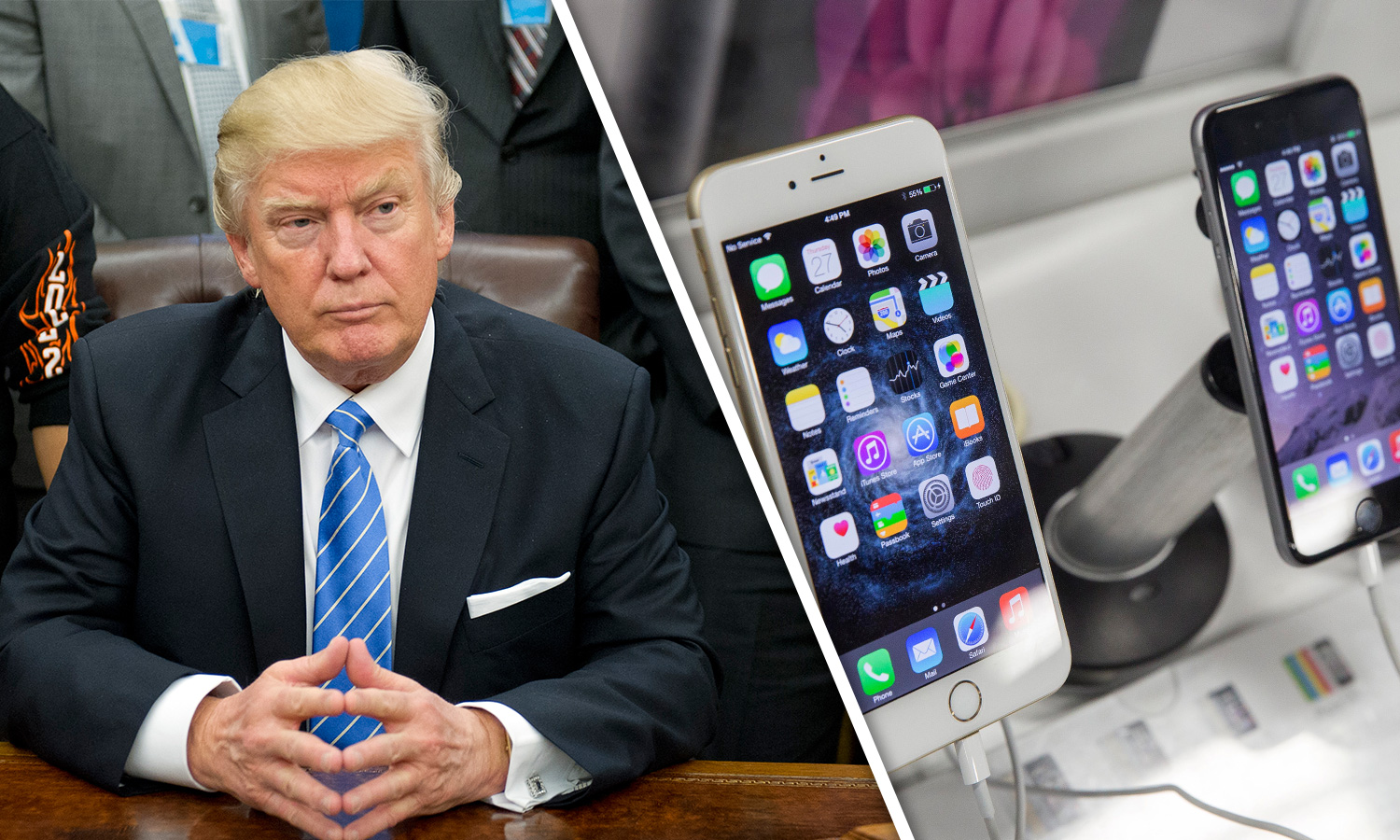Why Your Gadgets Might Cost More Under President Trump
Your next smartphone, laptop or game console could get a lot more expensive, depending on how President Donald J. Trump deals with trade policy.
Your next smartphone, laptop or game console could potentially get much more expensive. It all depends on how President Donald J. Trump deals with international trade policy — specifically, promised tariffs on imports, which he says could bring manufacturing back to the United States.

In December 2016, Trump’s campaign floated the idea of a tariff as high as 10 percent on all imports to encourage manufacturing in the United States. In January, he told The New York Times’ editorial board that he wants a tax of 45 percent on imports from China. Just yesterday (Jan. 26), Trump’s press secretary, Sean Spicer, said a border wall between Mexico and the United States could be funded by a 20 percent import tax (though he later claimed that was simply an idea, not a policy statement).
According to an analysis of International Trade Commission data by CNBC, imports from China came with an average import duty rate of 3 percent in 2015; the average rate on “electrical machinery and equipment” (such as audio and televisions) was 0.7 percent.
No matter what tech company puts its logo on your gear, its devices are almost certainly manufactured in China or other parts of Asia. Dell, HP and Apple are based in the United States, but their computers are actually built by manufacturers in China, Taiwan and other parts of Asia such as Foxconn, Quanta and Pegatron. The tech industry is hardly alone; a vast array of consumer goods, from clothing to children's toys, are made in China.
So when Trump says he wants to impose tariffs, the tech industry’s ears perk up, because these policies will affect how much they spend, and those costs will likely be passed on to consumers, experts tell Tom’s Guide.
MORE: 25 Cheap Tech Products That Make Life Easier
Higher Prices, Fewer Choices
If such tariffs are indeed imposed, U.S. tech companies will have a few options.
Sign up to get the BEST of Tom's Guide direct to your inbox.
Get instant access to breaking news, the hottest reviews, great deals and helpful tips.
“If sizeable tariffs are slapped on imports, U.S. firms can either try to source the products from somewhere else, including within the U.S.; accept lower profits; or increase prices,” said Mark Williams, chief Asia economist at Capital Economics.
That scenario would align with a major theme from Trump’s inaugural address: "We will follow two simple rules: buy American and hire American,” the president said.
But Williams noted that because no other country can produce electronics on the same scale as China, there’s nowhere else to go. Stephen Baker, vice president and techology analyst at market research firm NPD, added that it could take three years or more for companies with the means to move manufacturing to the U.S. to do so, and prices could still be high.
“If sizable tariffs are slapped onto imports, U.S. firms can either try to source the products from somewhere else, including within the U.S.; accept lower profits; or increase prices.” — Mark Williams, chief Asia economist, Capital Economics
Profit margins in tech can be razor-thin, so absorbing any costs imposed by tariffs is an unlikely business decision. Instead, vendors are more likely to reconsider what tech they sell in the U.S., said Max Wolff, market strategist at 55 Capital.
“Much of the price increases are likely to be passed on,particularly in the lower-cost goods,” Wolff said. “This is because margins are very thin and competition has been intense.”
Additionally, some products might not come to the U.S., leading to fewer choices and lower sales volumes, Wolff said.
Most companies are often managing costs behind the scenes to account for changes in the price of their devices’ components, Baker noted. “But large manufacturing-cost increases due to tariffs would lead to prices that “rise commensurate with that cost,” he said.
MORE: The Mother Lode of Galaxy S8 Leaks Just Landed
Lots of Unknowns
There are still some unknowns, largely because Trump’s team hasn’t provided any concrete details, including when and if these tariffs will actually appear. That makes it impossible to speculate what the exact cost increase would be. But according to Wolff, cost increases should be similar for both U.S.-based vendors such as Apple and Dell and companies such as Lenovo and ZTE that are headquartered overseas.
But others are more cautious in their forecasts.Christine Lagarde, managing director of the International Monetary Fund, thinks Trump’s tax and infrastructure spending plans will be good for the U.S. economy. In an interview with Bloomberg, Lagarde said it’s too early to make any predictions.
“...The team is waiting to see what the outcome will be,” Lagarde said. “We’re lost in conjecture for the moment.”

The White House did not respond to messages from Tom’s Guide, including emails to Spicer and spokesperson Hope Hicks, and messages sent via the White House’s web form. Trump did not respond to a request for comment through Twitter direct messaging on his personal account, @realDonaldTrump. (He leaves his DMs open.)
Tom’s Guide also reached out to a number of consumer electronics vendors — including Dell, HP, Apple, Lenovo, Acer, Samsung and Asus — but did not receive responses. We will update this story if we hear back.
MORE: The Making of Dell's XPS 13 2-in-1
Made in the USA?
Tech companies may move some jobs to the United States, but they may not necessarily do so to decrease costs. Wolff pointed out that companies may produce devices, or parts of devices, in the United States in an attempt to get on the government’s good side. (The government buys a lot of tech products.)
“It is important to note that the costs of moving production to the U.S. would also be very high,” Baker said, “and even once that process was complete, pricing might remain at the prior high level” due to tariffs on imported parts and additional costs associated with building a supply chain in the U.S., including the increased cost of labor.
Besides the optics of being on U.S. soil, locating factories here could mean huge economic boons for companies. According to a recent report from The Wall Street Journal, Foxconn is looking to build a $7 billion factory (possibly a joint investment with Apple) in the United States to make flat-panel screens. According to that report, the company would require considerable government incentives to build such a facility.
“Trump is challenging the articulation and execution of modern supply chains and the way that electronics are licensed, made and sold.” — Max Wolff, market strategist, 55 Capital
What we haven’t seen are reports suggesting that entire devices will be made here, meaning that phones and computers will still have to be shipped from overseas for the foreseeable future. As such, tariffs will still apply.
And if Trump’s proposals become law, the entire industry can be thrown into a state of uncertainty.
“As presently threatened, Trump is challenging the articulation and execution of modern supply chains and the way that electronics are licensed, made and sold,” Wolff said. “It is not clear what [the] final rule changes [will] look like, but we seem to be trying to close a barn door after horses escaped. Expect other doors to be slammed shut and a period of destabilization to follow.”
Andrew E. Freedman is an editor at Tom's Hardware focusing on laptops, desktops and gaming as well as keeping up with the latest news. He holds a M.S. in Journalism (Digital Media) from Columbia University. A lover of all things gaming and tech, his previous work has shown up in Kotaku, PCMag, Complex, Tom's Guide and Laptop Mag among others.
-
punk4evr I believe that the it is a total fallacy that companies will move back to the usa and here's why. First the Cost to build a new factory here, is much much greater than in many other places ( due to labor costs and now steel costs). Also the difference in employee pay rates alone, would most likely still make the cost of operation in the USA much more than the Tariff or Tax. So you add the increased cost of employee payment and the new facility construction costs will totally not offset the difference operation costs to move back to the USA.Reply -
AndrewFreedman Reply19218215 said:I believe that the it is a total fallacy that companies will move back to the usa and here's why. First the Cost to build a new factory here, is much much greater than in many other places ( due to labor costs and now steel costs). Also the difference in employee pay rates alone, would most likely still make the cost of operation in the USA much more than the Tariff or Tax. So you add the increased cost of employee payment and the new facility construction costs will totally not offset the difference operation costs to move back to the USA.
The analysts I spoke agreed it would be very difficult -- could take years if they tried. Besides labor and facilities, you would still need to import parts, and those would have tariffs, too. So you're right in that there would definitely be costs that companies would probably want to make up for.

